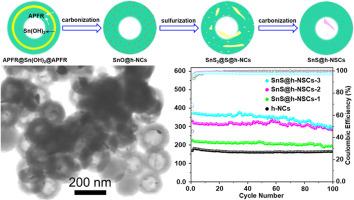氮/硫共掺杂中空碳球中硫化锡的夹层约束工程
IF 7.9
2区 工程技术
Q1 CHEMISTRY, PHYSICAL
引用次数: 0
摘要
由于碳材料的超低钠离子存储容量(300 mAh g−1),将高容量组件集成到碳基体中引起了广泛关注。为了最大限度地发挥高钠存储容量复合材料的优势,并减轻其常见缺点(体积膨胀、电子导电性差和Na+扩散动力学缓慢),碳基体的微观结构和形态优化至关重要。在此,开发了一种三明治约束策略,将高钠存储容量的SnS限制在N/ s共掺杂的空心双碳层球中(SnS@h-NSCs)。坚固的Sn-C和C-S键促进了结构稳定性和sn与N/ s共掺杂碳基体之间的强界面相互作用。随着SnS负载的增加,SnS@h-NSCs中优化后的双层碳基质有效地缓解了体积膨胀,增强了电子导电性,促进了Na+的迁移动力学。结果表明,与空心掺n碳球(h-NCs)相比,钠离子电池中的阳极SnS@h-NSCs的初始放电容量从464 mAh g−1提高到710 mAh g−1,初始库仑效率从50.5%提高到68.3%。低sn -负载SnS@h-NSCs表现出优异的可逆性,而高sn -负载SnS@h-NSCs在100次循环后表现出适度的容量衰减,这突出了通过强sn -碳相互作用(Sn-C和C-S键)减轻体积膨胀、促进稳定性、高效电子传递和Na+迁移的结构完整性的重要性,并强调了在高活性物质含量下保持结构完整性的挑战。本文章由计算机程序翻译,如有差异,请以英文原文为准。

Sandwich confinement engineering of tin sulfide in nitrogen/sulfur-co-doped hollow carbon spheres for efficient sodium storage
Due to the ultralow sodium-ion storage capacity (300 mAh g−1) of carbon materials, incorporating high-capacity components into a carbon matrix has attracted wide attention. To maximize the advantages of high-sodium-storage-capacity composites and mitigate common drawbacks (volume expansion, poor electronic conductivity, and sluggish Na+ diffusion kinetics), the microstructural and morphological optimization of the carbon matrix is crucial. Herein, a sandwich confinement strategy was developed to confine SnS — a high-sodium-storage-capacity — within N/S-co-doped hollow double carbon layered spheres (SnS@h-NSCs). Robust Sn-C and C-S bonds promote structural stability and strong interfacial interactions between SnS and the N/S-co-doped carbon matrix. With increasing SnS loading, the optimized double-layer carbon matrix in SnS@h-NSCs efficiently alleviated volume expansion and enhanced electronic conductivity and facilitated Na+ migration kinetics. As a result, the anodic SnS@h-NSCs in sodium-ion batteries exhibited significant improvements in initial discharge capacities from 464 to 710 mAh g−1 and the initial Coulombic efficiencies from 50.5 to 68.3 % compared to hollow N-doped carbon spheres (h-NCs). Low-SnS-loading SnS@h-NSCs showed excellent reversibility, while high SnS-loading SnS@h-NSCs exhibited a moderate capacity fading after 100 cycles, highlighting the importance of structural integrity through strong SnS‒carbon interactions (Sn‒C and C‒S bonds) in mitigating the volume expansion, and promoting stability, efficient electron transport, and Na+ migration, and underscoring the challenge of maintaining structural integrity at elevated active material content.
求助全文
通过发布文献求助,成功后即可免费获取论文全文。
去求助
来源期刊

Journal of Power Sources
工程技术-电化学
CiteScore
16.40
自引率
6.50%
发文量
1249
审稿时长
36 days
期刊介绍:
The Journal of Power Sources is a publication catering to researchers and technologists interested in various aspects of the science, technology, and applications of electrochemical power sources. It covers original research and reviews on primary and secondary batteries, fuel cells, supercapacitors, and photo-electrochemical cells.
Topics considered include the research, development and applications of nanomaterials and novel componentry for these devices. Examples of applications of these electrochemical power sources include:
• Portable electronics
• Electric and Hybrid Electric Vehicles
• Uninterruptible Power Supply (UPS) systems
• Storage of renewable energy
• Satellites and deep space probes
• Boats and ships, drones and aircrafts
• Wearable energy storage systems
 求助内容:
求助内容: 应助结果提醒方式:
应助结果提醒方式:


